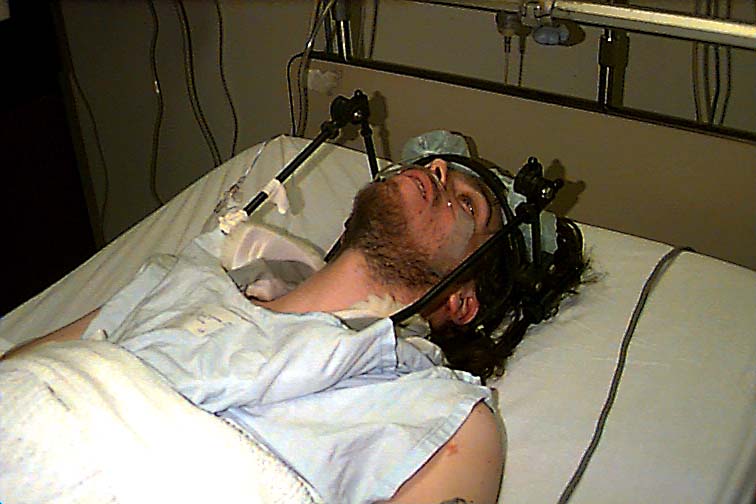 Go to Front Page
Go to Front Page  Go to Scenarios
Go to Scenarios  Go
to Techniques
Go
to Techniques
Drugs used in Emergency Intubation
Contents of this bit:
Induction Agents -
Propofol
Induction agent with great recovery profile but hemodynamic instability
Dose - 2-2.5 mg/kg, titrate to effect
Side Effects - Hypotension, apnea, pain on injection
Duration - 5-10 minutes
Clearance - Hepatic, Extrahepatic
Etomidate
Induction agent with least hemodynamic depression
Dose - 0.1-0.4 mg/kg
Side Effects - Hypotenstion, myoclonus, apnea, adrenalcortical suppression
Duration - 3-10 minutes
Clearance - Hepatic
Ketamine
Induction agent with central sympathetic stimulation
Dose - 1-2.5 mg/kg
Side Effects - Hyper-/Hypo-tenstion, tachycardia, delirium, hypersalivation
Duration - 5-15 minutes
Clearance - Hepatic
Thiopental
Most commonly used induction agent
Dose - 3-5 mg/kg
Side Effects - Hypotension, histamine release, apnea
Duration - 5-15 minutes
Clearance - Hepatic
Sedatives -.
Midazolam
Benzodiazepine with moderate respiratory and cardiovascular stability
Dose - 0.5 mg i.v. titrated to sedation
Side Effects - Respiratory and cardiovascular depression, especially when
given with narcotics
Duration - 2-6 hours, much longer after prolonged use
Clearance - Renal
Fentanyl
Synthetic opioid with cardiovascular stability and short duration of effect
Dose - 0.7-2.0 ug/ml
Side Effects - Respiratory depression, hypotension, muscle rigidity
Duration - 30-60 minutes
Clearance - Hepatic
Scopolamine
Sedative, amnestic with minimal cardiovascular changes
Dose - 0.2-0.65 mg
Side Effects - Nausea, confusion, disorientation
Duration - 2 hours
Clearance - Reanl, Hepatic
Muscle Relaxants -
Succinylcholine
Depolarizing muscle relaxant, best for rapid sequence
Dose - 1 mg/kg
Side Effects - Dysrhythmias, increased intracranial pressure, increased
intraocular pressure, increased intragastric pressure, hyperkalemia in burns,
crush injury, spinal cord injury and children with myopathies, MH, muscle
damage, sux apnea
Onset - 30-60 seconds
Duration - 4-6 minutes
Clearance - Plasma pseudocholinesterase
Vecuronium
Nondepolarizing agent that is the most cardiac clean.
Dose - 0.1 mg/kg, may increase to decrease onset time
Side Effects - Essentially none
Onset - 2-3 minutes
Duration - 25-30 minutes
Clearance - Hepatic, Renal
Rocuronium
Intermediate acting nondepolarizing agent with most rapid onset
Dose - 0.6 mg/kg, may be increased to 1.2 mg/kg to decrease onset time
Side Effects - Essentially none
Onset - 1-2 minutes
Duration - 20-30 minutes
Clearance - Hepatic
Atracurium
Nondepolarizing agent with clearance not dependent on hepatic or renal mechanisms
Dose - 0.5 mg/kg, may increase to decrease onset time
Side Effects - Histamine release, hypotenstion
Onset - 2-3 minutes
Duration - 20-35 minutes
Clearance - Plasma (Hoffman elimination, ester hydrolysis)
Cis-atracurium
One of the isomers in atracurium, nondepolarizing agent with clearance not
dependent on hepatic or renal mechanisms. Clean atracurium
Dose - 0.2 mg/kg, may increase to decrease onset time
Side Effects - No histamine release or BP changes
Onset - 2-3 minutes
Duration - 45 -60 minutes
Clearance - Hoffman elimination
Pancuronium
Long acting NMB with tachycardic effects
Dose - 0.1 mg/kg
Side Effects - Tachycardia due to vagolysis and sympathetic effects
Onset - 3-5 minutes
Duration - 60-90 minutes
Clearance - Liver
Miscellaneous -
Lidocaine
Antiarythmic local anesthetic
Uses - Ventricular dysrhythmia, regional anesthesia, topical anesthetic,
attenuation of pressor response to laryngoscopy
Dose - 1 mg/kg , i.v. and 0.6-3 mg/kg, topical
Side Effects - arrythmias, CNS Toxicity
Onset - 45-90 seconds, i.v.
Duration - 10-20 minutes, i.v.; 30-60 minutes, topically
Clearance - Hepatic, Pulmonary
 Go to Front Page
Go to Front Page
 Go to Scenarios
Go to Scenarios
 Go
to Techniques
Go
to Techniques